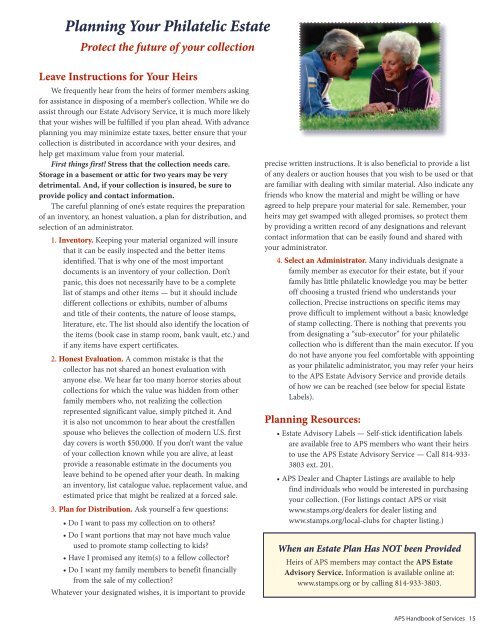pdf format - American Philatelic Society
pdf format - American Philatelic Society
pdf format - American Philatelic Society
Create successful ePaper yourself
Turn your PDF publications into a flip-book with our unique Google optimized e-Paper software.
Planning Your <strong>Philatelic</strong> Estate<br />
Protect the future of your collection<br />
Leave Instructions for Your Heirs<br />
We frequently hear from the heirs of former members asking<br />
for assistance in disposing of a member’s collection. While we do<br />
assist through our Estate Advisory Service, it is much more likely<br />
that your wishes will be fulfilled if you plan ahead. With advance<br />
planning you may minimize estate taxes, better ensure that your<br />
collection is distributed in accordance with your desires, and<br />
help get maximum value from your material.<br />
First things first! Stress that the collection needs care.<br />
Storage in a basement or attic for two years may be very<br />
detrimental. And, if your collection is insured, be sure to<br />
provide policy and contact in<strong>format</strong>ion.<br />
The careful planning of one’s estate requires the preparation<br />
of an inventory, an honest valuation, a plan for distribution, and<br />
selection of an administrator.<br />
1. Inventory. Keeping your material organized will insure<br />
that it can be easily inspected and the better items<br />
identified. That is why one of the most important<br />
documents is an inventory of your collection. Don’t<br />
panic, this does not necessarily have to be a complete<br />
list of stamps and other items — but it should include<br />
different collections or exhibits, number of albums<br />
and title of their contents, the nature of loose stamps,<br />
literature, etc. The list should also identify the location of<br />
the items (book case in stamp room, bank vault, etc.) and<br />
if any items have expert certificates.<br />
2. Honest Evaluation. A common mistake is that the<br />
collector has not shared an honest evaluation with<br />
anyone else. We hear far too many horror stories about<br />
collections for which the value was hidden from other<br />
family members who, not realizing the collection<br />
represented significant value, simply pitched it. And<br />
it is also not uncommon to hear about the crestfallen<br />
spouse who believes the collection of modern U.S. first<br />
day covers is worth $50,000. If you don’t want the value<br />
of your collection known while you are alive, at least<br />
provide a reasonable estimate in the documents you<br />
leave behind to be opened after your death. In making<br />
an inventory, list catalogue value, replacement value, and<br />
estimated price that might be realized at a forced sale.<br />
3. Plan for Distribution. Ask yourself a few questions:<br />
• Do I want to pass my collection on to others<br />
• Do I want portions that may not have much value<br />
used to promote stamp collecting to kids<br />
• Have I promised any item(s) to a fellow collector<br />
• Do I want my family members to benefit financially<br />
from the sale of my collection<br />
Whatever your designated wishes, it is important to provide<br />
precise written instructions. It is also beneficial to provide a list<br />
of any dealers or auction houses that you wish to be used or that<br />
are familiar with dealing with similar material. Also indicate any<br />
friends who know the material and might be willing or have<br />
agreed to help prepare your material for sale. Remember, your<br />
heirs may get swamped with alleged promises, so protect them<br />
by providing a written record of any designations and relevant<br />
contact in<strong>format</strong>ion that can be easily found and shared with<br />
your administrator.<br />
4. Select an Administrator. Many individuals designate a<br />
family member as executor for their estate, but if your<br />
family has little philatelic knowledge you may be better<br />
off choosing a trusted friend who understands your<br />
collection. Precise instructions on specific items may<br />
prove difficult to implement without a basic knowledge<br />
of stamp collecting. There is nothing that prevents you<br />
from designating a “sub-executor” for your philatelic<br />
collection who is different than the main executor. If you<br />
do not have anyone you feel comfortable with appointing<br />
as your philatelic administrator, you may refer your heirs<br />
to the APS Estate Advisory Service and provide details<br />
of how we can be reached (see below for special Estate<br />
Labels).<br />
Planning Resources:<br />
• Estate Advisory Labels — Self-stick identification labels<br />
are available free to APS members who want their heirs<br />
to use the APS Estate Advisory Service — Call 814-933-<br />
3803 ext. 201.<br />
• APS Dealer and Chapter Listings are available to help<br />
find individuals who would be interested in purchasing<br />
your collection. (For listings contact APS or visit<br />
www.stamps.org/dealers for dealer listing and<br />
www.stamps.org/local-clubs for chapter listing.)<br />
When an Estate Plan Has NOT been Provided<br />
Heirs of APS members may contact the APS Estate<br />
Advisory Service. In<strong>format</strong>ion is available online at:<br />
www.stamps.org or by calling 814-933-3803.<br />
APS Handbook of Services 15

















